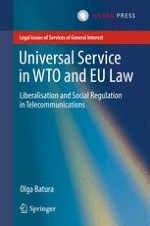2016 | OriginalPaper | Chapter
5. Transformation of Universal Service for the Future
Author : Olga Batura
Published in: Universal Service in WTO and EU law
Publisher: T.M.C. Asser Press
Activate our intelligent search to find suitable subject content or patents.
Select sections of text to find matching patents with Artificial Intelligence. powered by
Select sections of text to find additional relevant content using AI-assisted search. powered by
